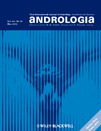High frequency of sexual dysfunction in patients with male accessory gland infections
Summary
The aim of this study was to administer to two groups of patients with male accessory gland infection (MAGI), respectively, with positive or negative alterations in ultrasonography, a new diagnostic interview, arbitrarily named structured interview about MAGI (SI-MAGI), to evaluate differences between these groups, especially about the prevalence of sexual dysfunction. After ultrasound examinations, patients with MAGI were divided into two age-matched groups: positive and negative for ultrasound signs (US+ and US−). The SI-MAGI was structured into four domains (urinary tract symptoms, ejaculatory pain or discomfort, sexual dysfunction and quality-of-life impact) for a total of 30 questions with four possible answers. Infertile patients of MAGI US+ group showed scores significantly higher than MAGI US− and healthy control group in all domains (anovaP < 0.005) in relation to scores of patients with MAGI US+ and US−: in domain 1 = 16.0 ± 0.5 vs 9.0 ± 0.5, domain 2 = 21.0 ± 1.0 vs 11.0 ± 1.0, domain 3 = 23.0 ± 0.5 vs 12.0 ± 1.0 and, finally, in domain 4 = 13.0 ± 2.0 vs 6.0 ± 1.0. In particular, a higher frequency of sexual dysfunction (52%) was detected in MAGI US+ group when compared with MAGI US− (28%). This study introduces a specific set of questions, which combined with the sperm analysis, microbiological and ultrasound investigations, that altogether better express the clinical presentation of MAGI. Finally, MAGI US+ group showed a high percentage of sexual dysfunction.




